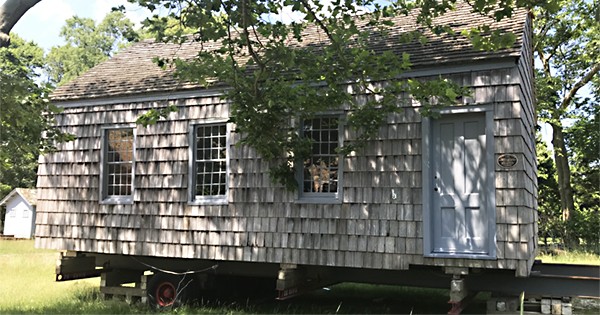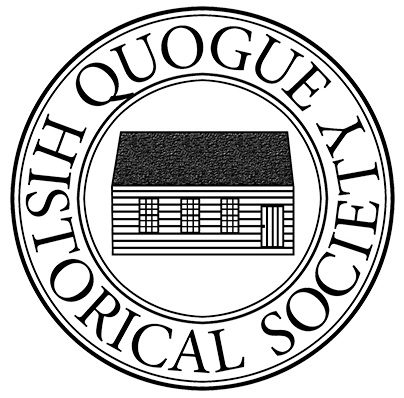1822 Schoolhouse: 2019-2021 Restoration

Quogue’s 1822 one-room Schoolhouse, said to be the oldest surviving schoolhouse building on the East End of Long Island, is indisputably the most important historic public building in the Village. The 198-year-old building is not only a rare example of its type and form, it preserves a remarkably high degree of architectural integrity.
When built, Quogue’s Schoolhouse appears to have been an exception to the rule for early one-room schoolhouses, often the shabbiest and most neglected building in a village. The size of the building – approximately 18 feet by 32 feet – is in the mid-range of schoolhouses of the period, but it has an entrance hall, which is unusual. The entrance hall and the large classroom both feature vaulted barrel ceilings, also not typical. The six 12-over-12 window sashes are over-sized, to maximize the light. A stove for heating was once centered in the classroom and vented through a brick chimney in the attic.
Since opening as a museum in 1949, repairs and restoration of the one-room schoolhouse have been ongoing, including installation of electricity in 1962; new cedar posts in 1969; a new foundation in 1975; and a new roof in 1979. The exterior was re-shingled in 1987 (below), and the roof in 1997.
The required relocation of the Schoolhouse offered the Historical Society an opportunity to undertake critical repairs and restoration work on the building. It has also been almost 20-years years since the last major restoration project.
To that end, in 2017, the Quogue Historical Society hired preservation consultant Joel Snodgrass, Principal, Steward Preservation Services, and architectural historian and former Southampton Town Historian Zach Studenroth to undertake a conditions assessment of the Schoolhouse and make recommendations for exterior and interior restoration work. The results of the building assessment are outlined in the following, along with a description of the work in three phases and the estimated cost.
Building Description & Conditions Assessment
Steward Preservation Services
Exterior
The timber-framed Quogue Schoolhouse is a one story, gable-roofed four-bay structure that measures approximately 18’-6” wide by 31’-9” long, and 17’-5” high to its roof peak. Its walls are clad with sawn wood shingles with an exposure (weather) of 10”; its roof is covered with hand-split wood shingles measuring 24” in length with an 8” exposure.
The seven windows, five original, are configured as 12-over-12 with windowpanes measuring 6” by 8”. There are three windows on the front wall, one centered on each of the end walls, and two on the rear wall. In addition, a 12-over-12 window is centered on the wall of the attic story beneath the roof peak. The front door is a four-panel door from the mid-to-late 19th century.
Interior
The interior of the schoolhouse is organized into two spaces: an entry hall opposite the front door that stretches across the width of the building and measures 5’-3” wide by 17’-5” long, and the classroom, which measures 17’-2” wide by 24’-9” long. Each room preserves original pine floorboards, horizontal wall boards, vaulted plaster ceilings, and seven 12-over-12 windows.
The floorboards are tongue-and-groove, 8” wide. Their weathered surfaces indicate they are original to the structure; moreover, they preserve the evidence of a saddle within the doorway from the entry hall to the classroom as well as the position of the stove that was centered in the classroom. The floor is painted red; the degree of wear suggests that it was unpainted until the modern era. The baseboards are not historic.
The walls within the entry hall are horizontally boarded with wainscot from floor to ceiling, whereas those of the classroom are boarded below the windows and plastered above. Wall boards in the hall are finished with a ¼” edge bead and preserve hand-carved markings – e.g., initials, outline of a ship – and vary in width from 9” to 14”.
The classroom wall boards are also beaded and vary in width, some measuring as wide as 16”, and are capped with a ¾” chair rail that corresponds to the level of the windowsills.
The upper walls in the classroom are finished with plaster on wood lath, as is the barrel vault of the entry hall ceiling, although the arched classroom ceiling has been restored with plaster on wire mesh. This latter work likely dates to 1979, as suggested by a bronze plaque hanging in the hall. The arched contours of both ceilings rely on a system of supporting boards that stretch between the attic floor joists and the studs of the side walls; the curved profile of the arch is cut from the boards, which in turn support the wood lath that serves as a substrate for the plaster.
One of the defining features of the classroom are its large, 12-over-12 windows. Their size dis-proportionate to that of the room, as is typical of the schoolhouse form, which sought to bring as much light as possible into the space. The symmetrical configuration of twelve 6” by 8” windowpanes in each sash is a holdover from the late 18th century although the muntin profiles are typical of early 19th century design. Two of the windows – those which are centered on the gable walls – are modern replacements, easily distinguished from the period sashes because of their wide muntin profiles and beveled meeting rails.
Attic
The attic is accessible via a window centered below the peak of the roof and protected by a batten door. The 12-over-12 window is comparable in size, appearance, and technology to the others preserved in the building, but appears to have been installed in recent times, perhaps as part of the 1979 restoration. Its large size is inconsistent with common practice. Further, the section of early wall shingle (on display) that measures 33” wide and 63” long and corresponds to the dimensions of the attic window, suggesting the possibility that it was removed from this location.
The roof rafters, floor frame, and studs of the upper gable walls are exposed inside the attic, as is evidence of a catastrophic fire that charred floorboards, joists and ceiling lath. The exposed framing of hand-hewn rafters is original to the building.
At the center of the attic is a space between the floor joists that appears to mark the location of a pipe and a brick chimney that vented it through the roof. Adjacent to this opening is evidence of a hatch opening in the ceiling, now closed. Charred joists, roof rafters, floorboards, and ceiling lath indicate that a fire swept through this area of the attic at an early date.
Phased Restoration Work, Timetable, and Cost
Given the schedule of the Library’s expansion project, and due to funding requirements, the Society is undertaking restoration of the Schoolhouse in three phases.
Phase I was completed in fall 2019. The building was relocated to the east side of the Library grounds and a new historically accurate foundation using locust posts was constructed, along with a drainage system around the perimeter of the building.
Phase II, exterior restoration work, began in late-July 2020. In sum, the critical areas of Phase II include the deteriorated cedar shingles, on both the roof and sides of the building, caused by damaging effects of the weather, as well as exposure to collected organic debris from a canopy of adjacent trees in its previous location behind the Library. The risk of water infiltration of the interior causing plaster damage is high. The seven exterior wood window sashes and trim have also shown areas of degradation, and in some places, serious rotting.
Phase III, interior restoration work, will correct alterations to the original early 19th century historic fabric, including the addition of period-inappropriate baseboards, modern replacement of two windows, and removal of the brick chimney. Phase III work will begin in 2021.
The key elements of Phase II and III are outlined in the following. All restoration work will follow the guidelines set forth in The Secretary of the Interior’s Standards for the Treatment of Historic Properties.
PHASE II Exterior Work: Began in late-July 2020; completion by September 30, 2020
– Exterior. Re-shingle the roof. Clean the side shingles, removing all biological growth; treat with preservative. Repair damaged areas of wood trim. Repair front door at areas of cracking and rot. Replace existing hardware at the front entry door with salvaged period units or appropriate replica units to reflect the original design aesthetic. Install passive venting to attic/roof.
– Windows. Remove and fully restore all seven historic window sashes and frames/window openings
– Exterior entry way. Install a historically accurate entry way, including a brownstone step and a millstone.
– Attic. Clear all debris from attic space and clean. Prepare attic for housing of HVAC equipment. Remove the inappropriate 12-over-12 double-hung window from the north side attic gable and replace with a vertical plank/batten door to replicate the original, including hardware.
PHASE III Interior Work: Beginning December 2020
– Scrape, re-plaster, and repaint areas of the entry hall ceiling where plaster failure has occurred.
– Install new electrical and lighting systems.
– To restore the original historic aesthetic design: (1) Reinstall a salvaged or replica interior door between the classroom and hall, with period hardware or appropriate replica components; (2) Remove baseboard at wainscoting; (3) Remove vertical corner boards at wainscoting in the classroom; (4) Replace modern window units with more historically accurate replica units; and (5) Install a non-operable wood-burning stove, with stove pipe extending up to and through the ceiling.
Phase III is expected to take 4 months.
Estimated Total Cost of Restoration.
The total cost of the Schoolhouse restoration project is estimated to be $240,000. We are pleased to have received donations and pledges of approximately $90,000 from the members of our Board and certain close friends of the Historical Society.
To fund the remaining cost of approximately $150,000, the Historical Society is soliciting donations from members of the Quogue community. To acknowledge the generosity of those who give $2,500 or more, the Society will list the names of those donors on a bronze plaque outside the Schoolhouse.
“This worthy community enterprise … should appeal to all interested in the traditions, standards, and historic values that have made Quogue notable.”
Excerpt from original “Appeal for Restoration Funds”
letter to the residents of Quogue, 1947.
